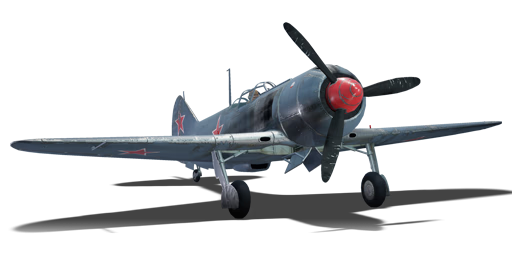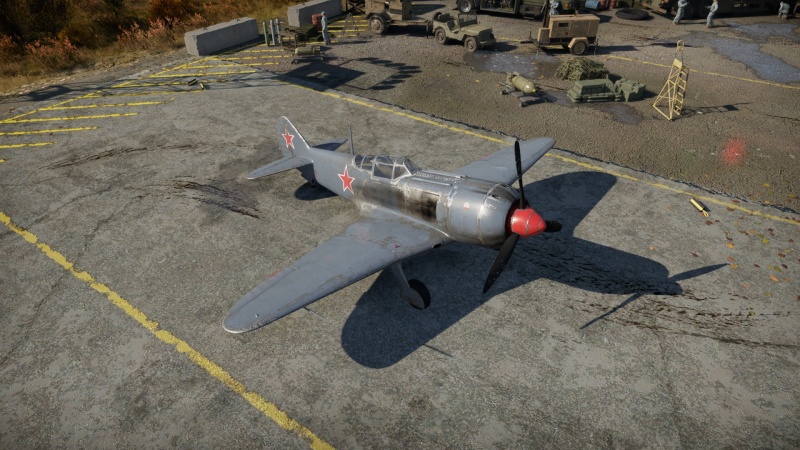La-7B-20
| This page is about the Soviet fighter La-7B-20. For other versions, see La-7 (Family). |
Contents
Description
The La-7 was originally intended to equip a set of three B-20S 20 mm cannons. However, due to reliability problems with said armament, two 20 mm ShVAK cannons were used instead, the same armament as the previous La-5 series of fighters. A total of 368 fighters equipped with B-20S cannons were produced before switching to the regular La-7. The three B-20 cannons were known as "three pointers" and were liked by test pilots.
It was introduced in Update 1.31. Compared to the regular La-7, the La-7B-20 has worse flight performance and fewer rounds per gun. However, with 3 guns instead of 2, each salvo fired is deadlier with the B-20 cannons. The aircraft has the same Shvetsov M-82FN as the La-7, the decreased flight performance can be attributed to the increased weight of the 3 x B-20 cannons. Try to use boom and zoom tactics, and stay below 4,000 m for dogfights for maximum engine performance.
General info
Flight performance
| Characteristics | Max Speed (km/h at 6,000 m) |
Max altitude (metres) |
Turn time (seconds) |
Rate of climb (metres/second) |
Take-off run (metres) | |||
|---|---|---|---|---|---|---|---|---|
| AB | RB | AB | RB | AB | RB | |||
| Stock | 636 | 614 | 10450 | 21.0 | 21.7 | 14.1 | 14.1 | 348 |
| Upgraded | 694 | 661 | 19.2 | 20.2 | 23.8 | 18.2 | ||
Details
| Features | ||||
|---|---|---|---|---|
| Combat flaps | Take-off flaps | Landing flaps | Air brakes | Arrestor gear |
| ✓ | ✓ | ✓ | X | X |
| Limits | ||||||
|---|---|---|---|---|---|---|
| Wings (km/h) | Gear (km/h) | Flaps (km/h) | Max Static G | |||
| Combat | Take-off | Landing | + | - | ||
| 735 | 320 | 504 | 471 | 300 | ~13 | ~13 |
| Optimal velocities (km/h) | |||
|---|---|---|---|
| Ailerons | Rudder | Elevators | Radiator |
| < 400 | < 400 | < 400 | > 341 |
Survivability and armour
- 55 mm Bulletproof Glass - Fore canopy
- 66 mm Bulletproof Glass - Rear canopy/headrest (75 mm with the modification researched)
- 8.5 mm Steel - Armour plate behind pilot's seat (10 mm with the modification researched)
Modifications and economy
Four upgrades are of importance: Offensive 20 mm, Compressor, Engine and Engine injection.
Armaments
Offensive armament
The La-7B-20 is armed with:
- 3 x 20 mm B-20S cannons, nose-mounted (130 rpg = 390 total)
Suspended armament
The La-7B-20 can be outfitted with the following ordnance:
- Without load
- 2 x 50 kg FAB-50 bombs (100 kg total)
- 2 x 100 kg FAB-100 bombs (200 kg total)
Usage in battles
The La-7B-20 is placed quite low in the Battle Rating spread, which means that you will still engage Rank III aircraft, the majority of which you will out-perform at low altitude.
The key to staying alive in the La-7 series lies in deceiving the enemy. By flying at around 4,500 m (15,000 ft) altitude, you present yourself as an easy target for Boom & Zoom aircraft that are flying at higher altitudes. When you spot someone diving at you, break off and evade his burst, while slowly luring him to lower altitude, then engaging in manoeuvre combat - this way you will start gaining the edge while the enemy loses his speed and momentum in the turn. Another habit worth developing in the La-7B-20 is ammo conservation; because the available load per gun has decreased compared to the La-7, combined with the quicker fire rate of the cannons, you can very quickly run out of ammo if you aren't careful. Thus, it is crucial to only take shots that you know will hit. By following these rules, you will soon find yourself efficiently researching the final Lavochkin piston fighter: the La-9.
One strength that you will want to take advantage of is the excellent low-altitude performance. Ideally, you want to engage your enemies at altitudes lower than 4 km. Higher up, the power output of the engine reduces drastically, making you an easy target. Aside from its speed, the La-7B-20 possesses very good turning capabilities - while it is not as good a turner as some British and Japanese designs, it can give many German and US aircraft a run for their money. Because of this manoeuvrability, good energy retention and speed, the La-7B-20 is very capable when engaging in defensive manoeuvres and duels, the latter being the ideal combat situation for the La-7.
Manual Engine Control
| MEC elements | ||||||
|---|---|---|---|---|---|---|
| Mixer | Pitch | Radiator | Supercharger | Turbocharger | ||
| Oil | Water | Type | ||||
| Not controllable | Controllable Not auto controlled |
Controllable Not auto controlled |
Controllable Not auto controlled |
Separate | Controllable 2 gears |
Not controllable |
Pros and cons
Pros:
- Excellent low altitude performance (<3,000 m)
- Decent manoeuvrability
- Great acceleration and climb
- Good roll rate
- Centre-mounted, powerful, accurate cannons
Cons:
- Poor performance at high altitude (>4,000 m)
- Poor maximum dive speed
- Fast-firing cannons burn through ammunition
History
The concept of a new fighter for the Soviet Air Force was pitched in 1943. While the earlier Lavochkin La-5 proved to be one of the best Soviet fighters produced up to that point, the main designer of the La-5, Semyon Lavochkin, felt that it could be improved even further. Work on a completely new fighter began in the early months of 1944. The new fighter was supposed to be an improved version of the La-5 design. The changes included the incorporation of a lighter and more durable metal airframe in place of the earlier wooden one. Other changes included the mounting of a new gun sight and propeller, as well as the strengthening of the landing gear struts and streamlining of the wings. It was to be armed with three Berezin B-20 20 mm cannons, however, the delay in production meant that most new La-7s were armed with 2 20 mm ShVAK cannons, like its predecessor. After more tests, the new fighter was accepted into serial production in late 1944.
In September 1944, the first La-7s found their way onto the front lines with the 63rd Guard Fighter Aviation Corps. The reception of the new fighter was warm - it was faster and more manoeuvrable than the La-5, which meant it could more efficiently tackle the most common German fighter the Soviets faced: the Messerschmitt Bf 109 G. In certain circumstances, the speed allowed the Soviet pilots to intercept Fw 190 fighter-bombers - a feat impossible to achieve for other Soviet fighters like the Yak-3. The main critiques of the design were considered to be the engine reliability and armament - the twin 20 mm ShVAK cannons were judged as inadequate in fights against better armoured Fw 190s. Still, the La-7 became one of the most successful Soviet piston fighters of World War II. Soviet ace Ivan Kozhedub scored 17 kills while flying the La-7 - his last one being an Me 262 jet. After the war the La-7 was replaced by the La-9 prop fighter, although many were still used by other communist states as both fighters and trainer aircraft.
| Archive of the in-game description | |
|---|---|
|
A single-seat cantilever monoplane fighter with a closed cockpit and retractable landing gear with a tail wheel. The La-7 was the successor to the La-5FN. Testing began on the experimental La-5 Benchmark 1944 in February 1944, and went into series production in May 1944 with the designation La-7. The La-5 Benchmark 1944 underwent tests with three synchronized Berezina B-20 aviation cannons. These new cannons were large-calibre UB machine guns redesigned for use with 20 mm rounds, and were not yet in series production. They were very light (only 25 kg) but unreliable. For this reason, the test reports recommended series production of the plane with the same armament as was used on the La-5FN – two 20 mm Shpitalny-Vladimirov ShVAK cannons. In October 1944, the B-20 cannons went into production at the Kovrov Ordnance Plant, and in January–February 1945, the La-7 underwent testing with them again. The in-flight firing results showed that the reliability of the cannons had improved, but was still lower than that of the ShVAK cannons. Nonetheless, a small batch of the fighters with three cannons (these were also called "three-pointers") was produced in the winter of 1944–1945 on the No. 381 Aviation Plant in Moscow. The La-7 was also tested with three experimental Shpitalny SH-20 cannons, but this cannon was never adequately tuned, so it failed to make its way into the series. The plane contained the twin-row air-cooled 14-cylinder A.D. Shvetsov ASH-82FN radial engine with a maximum output of 1,850 hp. Its firing armament consisted of three 20 mm synchronized Berezina B-20 cannons with 130 rounds each. The plane's bomb complement consisted of two detachable wing-mounted DZ-40 locking bomb racks, each of which could carry bombs with a calibre of up to 100 kg. It mostly used the general-purpose air-dropped FAB-50 and FAB-100 bombs, along with the ZAB-50 and ZAB-100 incendiary bombs and the AO-50 and AO-25 fragmenting bombs. Approximately 368 planes of this model were made. Further production was stopped owing to the unsatisfactory reliability of the B-20 cannons. However, combat pilots liked the "three-pointer" La-7 and, like the test pilots, did not complain about the weaponry's operation. | |
Media
- Skins
- Videos
See also
- Related development
External links
| Lavochkin Design Bureau (Лавочкинa Опытное конструкторское бюро) | |
|---|---|
| LaGG-3* | I-301 · LaGG-3-4 · LaGG-3-8 · LaGG-3-11 · LaGG-3-23 · LaGG-3-34 · LaGG-3-35 · LaGG-3-66 |
| La-5/7 | La-5 · La-5F · La-5FN · La-7 · Dolgushin's La-7 · La-7B-20 |
| La-9/11 | La-9 · La-11 |
| Jet Fighters | La-15 · La-174 · La-200 |
| Export | ␗La-9 · ␗La-11 |
| Captured | ▀La-5FN |
| *Lavochkin-Gorbunov-Gudkov (Лавочкин-Горбунов-Гудков), head designer V. P. Gorbunov | |
| USSR fighters | |
|---|---|
| I-15 | I-15 WR · I-15 M-22 · I-15 M-25 · I-15bis · Krasnolutsky's I-15bis |
| I-153 M-62 · Zhukovsky's I-153-M62 · I-153P | |
| I-16 | I-16 type 5 · I-16 type 10 · I-16 type 18 · I-16 type 24 · I-16 type 27 · I-16 type 28 · I-180S |
| I-29 | I-29 |
| I-185 | I-185 (M-71) · I-185 (M-82) |
| I-225 | I-225 |
| ITP | ITP (M-1) |
| MiG-3 | MiG-3-15 · MiG-3-15 (BK) · MiG-3-34 |
| LaGG | I-301 · LaGG-3-4 · LaGG-3-8 · LaGG-3-11 · LaGG-3-23 · LaGG-3-34 · LaGG-3-35 · LaGG-3-66 |
| La | La-5 · La-5F · La-5FN · La-7 · Dolgushin's La-7 · La-7B-20 · La-9 · La-11 |
| Yak-1/7 | Yak-1 · Yak-1B · Yak-7B |
| Yak-3 | Yak-3 · Eremin's Yak-3(e) · Yak-3P · Yak-3T · Yak-3U · Yak-3 (VK-107) |
| Yak-9 | Yak-9 · Yak-9B · Golovachev's Yak-9M · Yak-9T · Yak-9K · Yak-9U · Yak-9UT · Yak-9P |
| Other countries | ▂P-40E-1 · ▂P-47D-27 · ▂Hurricane Mk IIB · ▂Fw 190 D-9 · ▂Spitfire Mk IXc |
| P-39 | ▂P-39K-1 · ▂Pokryshkin's P-39N-0 · ▂P-39Q-15 |
| P-63 | ▂P-63A-5 · ▂P-63A-10 · ▂P-63C-5 |





